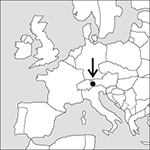
Source: MAPS IN MINUTES™ © RH Publications (1997)
Capital:
Vaduz
Area:
160 sq km (61.6 sq miles)
Population:
37,009 (2013 est)
Currency:
1 Swiss franc = 100 rappen (or centimes)
Religions:
Roman Catholic 75.9%; Protestant 7.6%; Muslim 5.4%
Ethnic Groups:
Liechtensteiner 65.6%
Languages:
German (official); Italian
International Organizations:
OSCE; EFTA; Council of Europe; WTO
In central Europe, one of the smallest countries in the world. It lies on the border between Austria and Switzerland, to the south of Lake Constance.
Physical
The western section of Liechtenstein occupies part of the floodplain of the upper Rhine, while to the east it extends up the forested and then snow‐covered slopes of the Rätikon Massif, part of the central Alps. Its mild climate is significantly affected by the warm Föhn wind from the south.
Economy
The economy is based on financial services. Low tax rates and easy incorporation rules have attracted foreign holding companies, which provide 30% of state revenues. Light manufacturing, tourism, and agriculture also play a role. The main exports are machinery and metal and chemical products. There is a customs and monetary union with Switzerland.
History
The principality of Liechtenstein was founded in 1719 when the two independent lordships of Schellenberg and Vaduz were united within the Holy Roman Empire. Liechtenstein remained part of the Empire until 1806, when it became part of the Rhine Federation. It joined the German Confederation in 1815 and became independent in 1866. A unicameral parliament was established by the 1921 constitution but the country has remained a monarchy, headed by the Prince. Any 900 persons or three communes may initiate legislation in the Diet (parliament). In 1989 Prince Hans‐Adam II (1945– ) succeeded his father, Prince Franz Joseph II (1906–89). Women were given the right to vote on national, but not local, issues in 1984. In 1992 a referendum approved Liechtenstein’s entry into the European Economic Area. A constitutional row began to develop in 1996 following the stated intention of the government to remove certain powers from Prince Hans‐Adam II, who announced that he would abandon the country unless he retained his full rights. In 2003 the Prince’s powers were increased. In 2004 his heir, Prince Alois (1968– ), became regent. The secrecy and opacity of Lichtenstein’s banking and tax systems attracted criticism in the 2000s, especially after the Credit Crunch. These issues were addressed by several bilateral information-sharing agreements with other countries in 2008–09 and the OECD removed the country from its ‘grey list’ of countries with secretive tax arrangements. Liechtenstein joined joined the Schengen Area in 2011.
- molal concentration
- molality
- molar
- molar conductivity
- molar density
- molar flow rate
- molar flux
- molar heat capacity
- molarity
- molar latent heat
- molar volume
- molasse
- Molasse Basin
- moldavite
- moldic porosity
- Moldova
- mole
- mole balance
- molecular beam
- molecular-beam epitaxy
- molecular biology
- molecular chaperone
- molecular clock
- molecular cloud
- molecular crystal